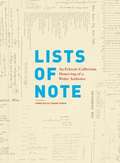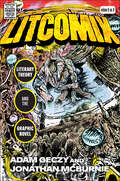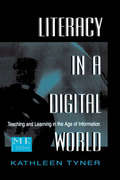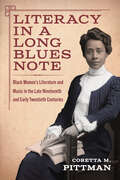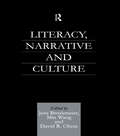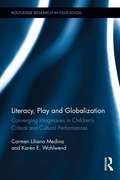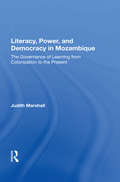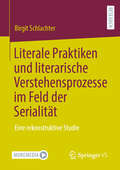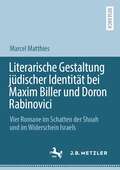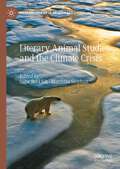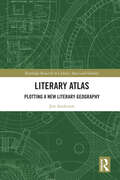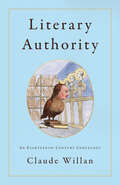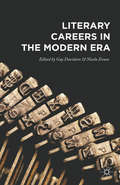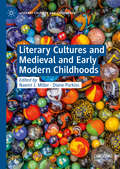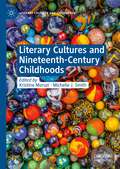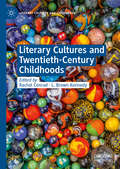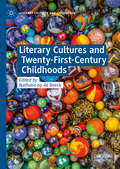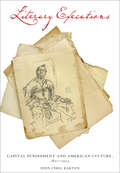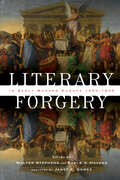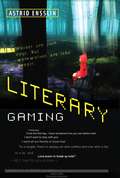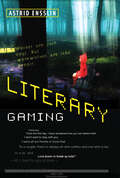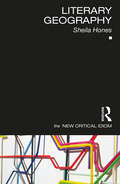- Table View
- List View
Lists of Note
by Shaun UsherLists of Note curates 125 unputdownable entries from a list of names that are as eclectic and intriguing as its contents, which include myriad reasons given by ancient Egyptians for missing work, Albert Einstein's demands of his estranged wife, F. Scott Fitzgerald's extensive conjugation of "to cocktail," and many more. Rarely intended for the public eye, these lists reveal hopes, priorities, and musings in a most engaging and entertaining way. Each transcript is accompanied by an artwork, most a captivating facsimile of the list itself. Richly visual and irresistibly readable, Lists of Note is a testament to the human urge to bring order to, poke fun at, and find meaning in the world around us--and is a gift of endless enjoyment and lasting value.
Litcomix: Literary Theory and the Graphic Novel
by Adam Geczy Jonathan McBurnieCritical studies of the graphic novel have often employed methodologies taken from film theory and art criticism. Yet, as graphic novels from Maus to Watchmen have entered the literary canon, perhaps the time has come to develop theories for interpreting and evaluating graphic novels that are drawn from classic models of literary theory and criticism. Using the methodology of Georg Lukács and his detailed defense of literary realism as a socially embedded practice, Litcomix tackles difficult questions about reading graphic novels as literature. What critical standards should we use to measure the quality of a graphic novel? How does the genre contribute to our understanding of ourselves and the world? What qualities distinguish it from other forms of literature? LitComix hones its theoretical approach through case studies taken from across the diverse world of comics, from Yoshihiro Tatsumi’s groundbreaking manga to the Hernandez Brothers’ influential alt-comix. Whether looking at graphic novel adaptations of Proust or considering how Jack Kirby’s use of intertextuality makes him the Balzac of comics, this study offers fresh perspectives on how we might appreciate graphic novels as literature.
Literacy in a Digital World: Teaching and Learning in the Age of Information (Routledge Communication Series)
by Kathleen TynerIn this book, Kathleen Tyner examines the tenets of literacy through a historical lens to demonstrate how new communication technologies are resisted and accepted over time. New uses of information for teaching and learning create a "disconnect" in the complex relationship between literacy and schooling, and raise questions about the purposes of literacy in a global, networked, educational environment. The way that new communication technologies change the nature of literacy in contemporary society is discussed as a rationale for corresponding changes in schooling. Digital technologies push beyond alphabetic literacy to explore the way that sound, image, and text can be incorporated into education. Attempts to redefine literacy terms--computer, information, technology, visual, and media literacies--proliferate and reflect the need to rethink entrenched assumptions about literacy. These multiple literacies are advanced to help users make sense of the information glut by fostering the ability to access, analyze, and produce communication in a variety of forms. Tyner explores the juncture between two broad movements that hope to improve education: educational technology and media education. A comparative analysis of these two movements develops a vision of teaching and learning that is critical, hands on, inquiry-based, and suitable for life in a mobile, global, participatory democracy.
Literacy in a Long Blues Note: Black Women’s Literature and Music in the Late Nineteenth and Early Twentieth Centuries (Margaret Walker Alexander Series in African American Studies)
by Coretta M. PittmanLiteracy in a Long Blues Note: Black Women’s Literature and Music in the Late Nineteenth and Early Twentieth Centuries traces the evolution of Black women’s literacy practices from 1892 to 1934. A dynamic chronological study, the book explores how Black women public intellectuals, creative writers, and classic blues singers sometimes utilize singular but other times overlapping forms of literacies to engage in debates on race. The book begins with Anna J. Cooper’s philosophy on race literature as one method for social advancement. From there, author Coretta M. Pittman discusses women from the Woman’s and New Negro Eras, including but not limited to Angelina Weld Grimké, Gertrude “Ma” Rainey, and Zora Neale Hurston. The volume closes with an exploration of Victoria Spivey’s blues philosophy. The women examined in this book employ forms of transformational, transactional, or specular literacy to challenge systems of racial oppression. However, Literacy in a Long Blues Note argues against prevalent myths that a singular vision for racial uplift dominated the public sphere in the latter decade of the nineteenth century and the early decades of the twentieth century. Instead, by including Black women from various social classes and ideological positions, Pittman reveals alternative visions. Contrary to more moderate predecessors of the Woman’s Era and contemporaries in the New Negro Era, classic blues singers like Mamie Smith advanced new solutions against racism. Early twentieth-century writer Angelina Weld Grimké criticized traditional methods for racial advancement as Jim Crow laws tightened restrictions against Black progress. Ultimately, the volume details the agency and literacy practices of these influential women.
Literacy, Narrative and Culture
by Min Wang David R. Olson Jens BrockmeierAn important contribution to the multi-disciplinary study of literacy, narrative and culture, this work argues that literacy is perhaps best described as an ensemble of socially and historically embedded activities of cultural practices. It suggests viewing written language, producing and distributing, deciphering and interpreting signs, are closely related to other cultural practices such as narrative and painting. The papers of the first and second parts illustrate this view in contexts that range from the pre-historical beginnings of tracking signs' in hunter-gatherer cultures, and the emergence of modern literate traditions in Europe in the 17th to 19th century, to the future of electronically mediated writing in times of the post-Gutenberg galaxy. The chapters of the third present results of recent research in developmental and educational psychology. Contributions by leading experts in the field make the point that there is no theory and history of writing that does not presuppose a theory of culture and social development. At the same time, it demonstrates that every theory and history of culture must unavoidably entail a theory and history of writing and written culture. This book brings together perspectives on literacy from psychology, linguistics, history and sociology of literature, philosophy, anthropology, and history of art. It addresses these issues in plain language – not coded in specialized jargon – and addresses a multi-disciplinary forum of scholars and students of literacy, narrative and culture.
Literacy, Play and Globalization: Converging Imaginaries in Children's Critical and Cultural Performances (Routledge Research in Education #115)
by Carmen L. Medina Karen E. WohlwendThis book takes on current perspectives on children’s relationships to literacy, media, childhood, markets and transtionalism in converging global worlds. It introduces the idea of multi-sited imaginaries to explain how children’s media and literacy performances shape and are shaped by shared visions of communities that we collectively imagine, including play, media, gender, family, school, or cultural worlds. It draws upon elements of ethnographies of globalization, nexus analysis and performance theories to examine the convergences of such imaginaries across multiple sites: early childhood and elementary classrooms and communities in Puerto Rico and the Midwest United States. In this work we attempt to understand that the local moment of engagement within play, dramatic experiences, and literacies is not a given but is always emerging from and within the multiple localities children navigate and the histories, possibilities and challenges they bring to the creative moment.
Literacy, Power, And Democracy In Mozambique: The Governance Of Learning From Colonization To The Present
by Judith MarshallThis book explores the relations between literacy and "people's power" in the context of Mozambique's project of socialist construction. It probes the tensions between literacy as a tool for grassroots democracy versus literacy as a tool for mobilizing at the base for top-down initiatives.
Literal Madness: 3 Novels: Kathy Goes to Haiti, My Death My Life by Pier Paolo Pasolini, and Florida
by Kathy AckerA collection of three novels from the experimental feminist writer: “Literal Madness is Acker at her most powerful, disturbing, and provocative.” —Catherine Texier, author of VictorineKathy Goes to Haiti, the first of three novels in Literal Madness, “speaks to us out of a delightful mock-naivete that reminds one at times of the Dick and Jane readers rewritten as manuals for politics and sex . . . At once hilarious and terrifying, [it] has all the logic of a Caribbean tour and a nightmare combined” (Los Angeles Times).My Death My Life by Pier Paolo Pasolini—wherein, among other things, the late Italian filmmaker solves his own murder, with the help of, among others, Romeo, Juliet, and the Bronté sisters—is a “scathing commentary on false values in art” (The Hartford Courant).In the haunting Florida, Acker achieves “a nearly telegraphic reduction of the Bogart-Bacall movie Key Largo to fatalistic, tough-guy essentials” (Booklist).“There’s a haunting method to Acker’s ‘madness’: a rough, raw, erudite wail against the postmodern loss of meaning and emotion.” —Kirkus Reviews
Literale Praktiken und literarische Verstehensprozesse im Feld der Serialität: Eine rekonstruktive Studie
by Birgit SchlachterBirgit Schlachter begründet theoretisch und empirisch eine Theorie literaler Praktiken, die in praxeologischer und individuell-kognitiver Perspektive den außerschulischen Literalitätserwerb und die Interpretationskultur im Handlungsraum eines Online-Forums zur Jugendromantrilogie „Die Tribute von Panem“ fokussiert. Im Zuge der Rekonstruktion von literarischen Verstehensprozessen rücken insbesondere emotional-wertende Rezeptionsprozesse und deren Einfluss auf das Verstehen eines literarischen Textes in den Blick. Ausgangspunkt der GTM-Studie ist ein Serialitätskonzept, das auf der Textbasis von rund 50 mehrbändigen Serien und Zyklen der aktuellen Jugendliteratur entwickelt wurde und das literale Praktiken von Leserinnen und Lesern einschließt.
Literarische Gestaltung jüdischer Identität bei Maxim Biller und Doron Rabinovici: Vier Romane im Schatten der Shoah und im Widerschein Israels
by Marcel MatthiesDie vorliegende Studie verfolgt das Anliegen, die komplexen und schwierigen Fragen jüdischer Identität und Selbstbeschreibung in der deutsch-jüdischen Gegenwartsliteratur einer fundierten Analyse zu unterziehen. Im Mittelpunkt der Untersuchung stehen Maxim Billers Romane Biografie (2016) und Sechs Koffer (2018) sowie Doron Rabinovicis Roman Andernorts (2010) und der (von ihm in Co-Autorschaft mit Natan Sznaider verfasste) Roman Herzl Relo@ded (2016). Beide viel beachteten Autoren bringen die Fragen innerjüdischen Selbstverständnisses ebenso in den Blick wie sie die Rollen Deutschlands, Österreichs und Israels als Kulissen und Resonanzräume für jüdische Existenz in der Gegenwart thematisieren. Im Zentrum der Interpretationen steht die Fragestellung, wie die jüdische Identitätsthematik in den vier Romanen bearbeitet und literarisch gestaltet wird. Die literaturwissenschaftliche Arbeit sucht die vor allem der Neuheit der Romane geschuldete Forschungslücke mithilfe politischer und soziologischer Theorie, psychoanalytischen und sozialpsychologischen Ansätzen sowie Impulsen aus der Gedächtnis- und Ideengeschichte zu schließen.
Literary Animal Studies and the Climate Crisis (Palgrave Studies in Animals and Literature)
by Matthias Stephan Sune BorkfeltLiterary Animal Studies and the Climate Crisis connects insights from the field of literary animal studies with the urgent issues of climate change and environmental degradation, and features considerations of new interventions by literature in relation to these pressing questions and debates. This volume informs academic debates in terms of how nonhuman animals figure in our cultural imagination of topics such as climate change, extinction, animal otherness, the posthuman, and environmental crises. Using a diverse set of methodologies, each chapter presents relevant cases which discuss the various aspects of these interstices. This volume is an intersection between literary animal studies and climate fiction intended as an interdisciplinary intervention that speaks to the global climate debate and is thus relevant across the environmental humanities.
Literary Atlas: Plotting a New Literary Geography (Routledge Research in Culture, Space and Identity)
by Jon AndersonThis book documents a new approach to literary geographies based around the Literary Atlas of Wales. It introduces an innovative "plotted" approach which empowers reading, creates connections to localities, histories, and communities, and inspires interest in literature and geography.It showcases how literary geographies can be mobilized through the plotted approach to reading. Through documenting the Literary Atlas of Wales project, this book outlines how the plotted approach was used to engage with English-language novels set in Wales. It argues that the future of this interdisciplinary subject area should be premised upon nurturing instability, turbulence, and experimentation in order to produce new insights which can change the way we understand the relations not only between literature and place but also between other modern categories, including academic disciplines.This book will be of interest to all readers of literature, human geography, mapping, heritage studies, and tourism. It will be beneficial to those interested in the domains of cartography, creative humanities, cultural sociology, human geography, literary studies, and print cultures.
Literary Authority: An Eighteenth-Century Genealogy
by Claude WillanThis book is the cultural history of an idea which now seems so self-evident as barely to be worth stating: through writing imaginative literature, an author can accrue significant and lasting economic and cultural power. We take for granted, now, that authority dwells in literature and in being its author. This state of affairs was not naturally occurring, but deliberately invented. This book tells the story of that invention. The story's central figures are Alexander Pope and Samuel Johnson. But its narrative begins in the 1680s, with the last gasp of the bond linking literary to political authority. While Jacobite poets celebrated (and mourned) the Stuart dynasty, Whig writers traced the philosophical and aesthetic consequences of the accession of William of Orange. Both groups left behind sets of literary devices ready-made to confer and validate authority. Claude Willan challenges the continued reign of the "Scriblerian" model of the period and shows how that reign was engineered. In so doing he historicizes the relationship between "good" and "bad" writing, and suggests how we might think about literature and beauty had Pope and Johnson not taken literary authority for themselves. What might literature have looked like, and what could we use it for, he provocatively asks.
Literary Black Power in the Caribbean: Fiction, Music and Film (African Diaspora Literary and Cultural Studies)
by Rita KeresztesiLiterary Black Power in the Caribbean focuses on the Black Power movement in the anglophone Caribbean as represented and critically debated in literary texts, music and film. This volume is groundbreaking in its focus on the creative arts and artists in their evaluations of, and insights on, the relevance of the Black Power message across the region. The author takes a cultural studies approach to bring together the political with the aesthetic, enriching an already fertile debate on the era and the subject of Black Power in the Caribbean region. The chapters discuss various aspects of Black Power in the Caribbean: on the pages of journals and magazines, at contemporary conferences that radicalized academia to join forces with communities, in fiction and essays by writers and intellectuals, in calypso and reggae music, and in the first films produced in the Caribbean. Produced at the 50th anniversary of the 1970 Black Power Revolution in Port of Spain, Trinidad, this timely book will be of interest to students and academics focusing on Black Power, Caribbean literary and cultural studies, African diaspora, and Global South radical political and cultural theory.
Literary Careers in the Modern Era
by Guy Davidson Nicola EvansThis is the first study of the shape and diversity of the literary career in the 20th and 21st centuries. Bringing together essays on a wide range of authors from Australia, Canada, the United States and the United Kingdom, the book investigates how literary careers are made and unmade, and how norms of authorship are shifting in the digital era.
Literary Cultures and Medieval and Early Modern Childhoods (Literary Cultures and Childhoods)
by Naomi J. Miller Diane PurkissBuilding on recent critical work, this volume offers a comprehensive consideration of the nature and forms of medieval and early modern childhoods, viewed through literary cultures. Its five groups of thematic essays range across a spectrum of disciplines, periods, and locations, from cultural anthropology and folklore to performance studies and the history of science, and from Anglo-Saxon burial sites to colonial America. Contributors include several renowned writers for children. The opening group of essays, Educating Children, explores what is perhaps the most powerful social engine for the shaping of a child. Performing Childhood addresses children at work and the role of play in the development of social imitation and learning. Literatures of Childhood examines texts written for children that reveal alternative conceptions of parent/child relations. In Legacies of Childhood, expressions of grief at the loss of a child offer a window into the family’s conceptions and values. Finally, Fictionalizing Literary Cultures for Children considers the real, material child versus the fantasy of the child as a subject.
Literary Cultures and Nineteenth-Century Childhoods (Literary Cultures and Childhoods)
by Kristine Moruzi Michelle J. SmithLiterary Cultures and Nineteenth-Century Childhoods explores the construction of the child and the development of texts for children in the nineteenth century through the application of fresh theoretical approaches and attention to aspects of literary childhoods that have only recently begun to be illuminated. This scope enables examination of the child in canonical nineteenth-century novels by Charles Dickens, Elizabeth Gaskell, Charlotte Bronte, and Thomas Hardy alongside well-known fiction intended for young readers by George MacDonald, Christabel Coleridge, and Kate Greenaway. The century was also distinctive for the rise of the children’s magazine, and this book broadens the definition of literary cultures to include magazines produced both by, and for, young people. The volume examines how the child and family are conceptualised, how children are positioned as readers in genres including the domestic novel, school story, Robinsonade, and fantasy fiction, how literary childhoods are written and politicised, and how childhood intersects with perceptions of animals and the natural environment. The range of chapters in this collection and the texts they consider demonstrates the variability and fluidity of literary cultures and nineteenth-century childhoods.
Literary Cultures and Twentieth-Century Childhoods (Literary Cultures and Childhoods)
by Rachel Conrad L. Brown KennedyThis collection of essays offers innovative methodological and disciplinary approaches to the intersection of Anglophone literary cultures with children and childhoods across the twentieth century. In two acts of re-centering, the volume focuses both on the multiplicity of childhoods and literary cultures and on child agency. Looking at classic texts for young audiences and at less widely-read and unpublished material (across genres including poetry, fiction, historical fiction or biography, picturebooks, and children’s television), essays foreground the representation of child voices and subjectivities within texts, explore challenges to received notions of childhood, and emphasize the role of child-oriented texts in larger cultural and political projects. Chapters frame themes of spectacle, self, and specularity across the twentieth-century; question tropes of childhood; explore identity and displacement in narrating history and culture; and elevate children as makers of literary culture. A major intent of the volume is to approach literary culture not just as produced by adults for consumption by children but also as co-created by young people through their actions as speakers, artists, readers, and writers.
Literary Cultures and Twenty-First-Century Childhoods (Literary Cultures and Childhoods)
by Nathalie op de BeeckIn the early decades of the twenty-first century, we are grappling with the legaciesof past centuries and their cascading effects upon children and all people. Werealize anew how imperialism, globalization, industrialization, and revolutioncontinue to reshape our world and that of new generations. At a volatile moment,this collection asks how twenty-first century literature and related mediarepresent and shape the contemporary child, childhood, and youth.Because literary representations construct ideal childhoods as well as model therights, privileges, and respect afforded to actual young people, this collectionsurveys examples from popular culture and from scholarly practice. Chaptersinvestigate the human rights of children in literature and international policy; thepotential subjective agency and power of the child; the role models proposed foryoung people; the diverse identities children embody and encounter; and theenvironmental well-being of future human and nonhuman generations.As a snapshot of our developing historical moment, this collection identifiesemergent trends, considers theories and critiques of childhood and literature,and observes how new technologies and paradigms are destabilizing pastconventions of storytelling and lived experience.
Literary Executions: Capital Punishment and American Culture, 1820–1925
by John Cyril Barton“Rich with historical detail . . . examines the figure and theme of the death penalty in imaginative literature from Cooper to Dreiser.” —Gregg Crane, Professor of English Language and Literature, University of MichiganDrawing from legal and extralegal discourse but focusing on imaginative literature, Literary Executions examines representations of, responses to, and arguments for and against the death penalty in the United States over the long nineteenth century. John Cyril Barton creates a generative dialogue between artistic relics and legal history. He looks to novels, short stories, poems, and creative nonfiction as well as legislative reports, trial transcripts, legal documents, newspaper and journal articles, treatises, and popular books (like The Record of Crimes, A Defence of Capital Punishment, and The Gallows, the Prison, and the Poor House), all of which were part of the debate over the death penalty.Barton focuses on several canonical figures—James Fenimore Cooper, Nathaniel Hawthorne, Lydia Maria Child, Walt Whitman, Herman Melville, and Theodore Dreiser—and offers new readings of their work in light of the death penalty controversy. Barton also gives close attention to a host of then-popular-but-now-forgotten writers—particularly John Neal, Slidell MacKenzie, William Gilmore Simms, Sylvester Judd, and George Lippard—whose work helped shape or was shaped by the influential anti-gallows movement.By engaging the politics and poetics of capital punishment, Literary Executions contends that the movement to abolish the death penalty in the United States should be seen as an important part of the context that brought about the flowering of the American Renaissance during the antebellum period and that influenced literature later in the nineteenth and early twentieth centuries
Literary Festivals and Contemporary Book Culture (New Directions in Book History)
by Millicent WeberThere has been a proliferation of literary festivals in recent decades, with more than 450 held annually in the UK and Australia alone. These festivals operate as tastemakers shaping cultural consumption; as educational and policy projects; as instantiations, representations, and celebrations of literary communities; and as cultural products in their own right. As such they strongly influence how literary culture is produced, circulates and is experienced by readers in the twenty-first century. This book explores how audiences engage with literary festivals, and analyses these festivals’ relationship to local and digital literary communities, to the creative industries focus of contemporary cultural policy, and to the broader literary field. The relationship between literary festivals and these configuring forces is illustrated with in-depth case studies of the Edinburgh International Book Festival, the Port Eliot Festival, the Melbourne Writers Festival, the Emerging Writers’ Festival, and the Clunes Booktown Festival. Building on interviews with audiences and staff, contextualised by a large-scale online survey of literary festival audiences from around the world, this book investigates these festivals’ social, cultural, commercial, and political operation. In doing so, this book critically orients scholarly investigation of literary festivals with respect to the complex and contested terrain of contemporary book culture.
Literary Forgery in Early Modern Europe, 1450–1800
by Janet E Gomez“The essays gathered in this volume demonstrate that studying early modern European literary forgeries is a fascinating cultural adventure” (Lina Bolzoni author of The Gallery of Memory).This comprehensive study of literary and historiographical forgery goes well beyond questions of authorship. It spotlights the imaginative vitality of forgery and its sinister impact on genuine scholarship. This volume demonstrates that early modern forgery was a literary tradition in its own right, with distinctive connections to politics, Greek and Roman classics, religion, philosophy, and modern literature. The early modern explosion in forgery of all kinds—particularly in the fields of literary and archaeological falsification—demonstrates a dramatic shift in attitudes toward historical evidence and in the relation of texts to contemporary society. The authors capture the impact of this evolution within many cultural transformations, including the rise of print, changing tastes and fortunes of the literary marketplace, and the Protestant and Catholic Reformations.The thirteen essays draw on Johns Hopkins University’s Bibliotheca Fictiva, the world’s premier research collection dedicated exclusively to the subject of literary forgery. It consists of several thousand rare books and unique manuscript materials from the early modern period and beyond.Contributors: Frederic Clark, James Coleman, Richard Cooper, Arthur Freeman, Anthony Grafton, A. Katie Harris, Earle A. Havens, Jack Lynch, Shana D. O’Connell, Ingrid Rowland, Walter Stephens, Elly Truitt, Kate Tunstall
Literary Gaming
by Astrid EnsslinIn this book, Astrid Ensslin examines literary videogames -- hybrid digital artifacts that have elements of both games and literature, combining the ludic and the literary. These works can be considered verbal art in the broadest sense (in that language plays a significant part in their aesthetic appeal); they draw on game mechanics; and they are digital-born, dependent on a digital medium (unlike, for example, conventional books read on e-readers). They employ narrative, dramatic, and poetic techniques in order to explore the affordances and limitations of ludic structures and processes, and they are designed to make players reflect on conventional game characteristics. Ensslin approaches these hybrid works as a new form of experimental literary art that requires novel ways of playing and reading. She proposes a systematic method for analyzing literary-ludic (L-L) texts that takes into account the analytic concerns of both literary stylistics and ludology.After establishing the theoretical underpinnings of her proposal, Ensslin introduces the L-L spectrum as an analytical framework for literary games. Based on the phenomenological distinction between deep and hyper attention, the L-L spectrum charts a work's relative emphases on reading and gameplay. Ensslin applies this analytical toolkit to close readings of selected works, moving from the predominantly literary to the primarily ludic, from online hypermedia fiction to Flash fiction to interactive fiction to poetry games to a highly designed literary "auteur" game. Finally, she considers her innovative analytical methodology in the context of contemporary ludology, media studies, and literary discourse analysis.
Literary Gaming (The\mit Press Ser.)
by Astrid EnsslinA new analytical framework for understanding literary videogames, the literary-ludic spectrum, illustrated by close readings of selected works.In this book, Astrid Ensslin examines literary videogames—hybrid digital artifacts that have elements of both games and literature, combining the ludic and the literary. These works can be considered verbal art in the broadest sense (in that language plays a significant part in their aesthetic appeal); they draw on game mechanics; and they are digital-born, dependent on a digital medium (unlike, for example, conventional books read on e-readers). They employ narrative, dramatic, and poetic techniques in order to explore the affordances and limitations of ludic structures and processes, and they are designed to make players reflect on conventional game characteristics. Ensslin approaches these hybrid works as a new form of experimental literary art that requires novel ways of playing and reading. She proposes a systematic method for analyzing literary-ludic (L-L) texts that takes into account the analytic concerns of both literary stylistics and ludology.After establishing the theoretical underpinnings of her proposal, Ensslin introduces the L-L spectrum as an analytical framework for literary games. Based on the phenomenological distinction between deep and hyper attention, the L-L spectrum charts a work's relative emphases on reading and gameplay. Ensslin applies this analytical toolkit to close readings of selected works, moving from the predominantly literary to the primarily ludic, from online hypermedia fiction to Flash fiction to interactive fiction to poetry games to a highly designed literary “auteur” game. Finally, she considers her innovative analytical methodology in the context of contemporary ludology, media studies, and literary discourse analysis.
Literary Geography (The New Critical Idiom)
by Sheila HonesLiterary Geography provides an introduction to work in the field, making the interdiscipline accessible and visible to students and academics working in literary studies and human geography, as well as related fields such as the geohumanities, place writing and geopoetics. Emphasising the long tradition of work with literary texts in human geography, this volume: provides an overview of literary geography as an interdiscipline, which combines aims and methods from human geography and literary studies explains how and why literary geography differs from spatially-oriented critical approaches in literary studies reviews geographical work with literary texts from the late 19th century to the present day includes a glossary of key terms and concepts employed in contemporary literary geography. Accessible and clear, this comprehensive overview is an essential guide for anyone interested in learning more about the history, current activity and future of work in the interdiscipline of literary geography.
